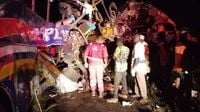In the quiet hours just after midnight on October 22, 2025, tragedy struck on one of Uganda’s busiest highways. Two buses, barreling along the Kampala-Gulu route in opposite directions, collided head-on near the town of Kiryandongo. The impact, which also involved a truck and a car, left at least 46 people dead and many more injured—making it one of the deadliest road accidents in Uganda in recent years, according to the Uganda Police Force and multiple news outlets including BBC and AP.
The initial aftermath was chaos and heartbreak. Police first reported a staggering death toll of 63, but later revised the number to 46 after discovering that some victims found unconscious at the scene were, in fact, still alive. "At the time of the crash, several victims were found unconscious, and some may have been mistakenly included in the initial fatality count," police clarified in a later statement, as reported by AP and Al Jazeera. Most of the injured were rushed to a nearby government hospital, where emergency workers and medical staff fought to save lives through the early morning hours.
According to footage and images verified by BBC, the devastation was immense. The buses’ windows were blown out, entire sections of their frames torn away, and the smaller vehicles—one truck and one car—were mangled almost beyond recognition. Irene Nakasiita, a spokesperson for the Red Cross, described the harrowing scene: "The magnitude of this incident is so big." She went on to say that the images were too gruesome to share publicly, noting that victims were left bleeding and with broken limbs. "At night even bystanders are not there," Nakasiita lamented, highlighting the additional dangers and delays in getting help after dark.
The collision occurred on the Kampala-Gulu highway, a critical artery connecting Uganda’s capital to its largest city in the north. It’s a busy, often perilous stretch of road. According to police, the crash was triggered when both bus drivers attempted to overtake other vehicles at the same time—a dangerous maneuver that led to the head-on collision. "In the process, both buses met head-on during the overtaking maneuvers," the Uganda Police Force explained in a statement on X (formerly Twitter). A chain reaction ensued, causing the truck and car to lose control and overturn multiple times.
Fatal road accidents are, sadly, a common occurrence in Uganda and much of East Africa. The highways are often narrow, poorly lit, and heavily trafficked by both private and commercial vehicles. In 2024 alone, Uganda recorded 5,144 deaths from road crashes, a grim increase from 4,806 in 2023 and 4,534 in 2022, according to official police figures cited by AP and Al Jazeera. Police attribute nearly half—44.5%—of these accidents to careless overtaking and speeding, as detailed in their latest crime report.
In a statement following the crash, police urged, "As investigations continue, we strongly urge all motorists to exercise maximum caution on the roads, especially avoiding dangerous and careless overtaking, which remains one of the leading causes of crashes in the country." The message was clear: reckless driving, particularly overtaking on busy highways, remains a deadly problem.
Ugandan President Yoweri Museveni, who was campaigning nearby for the country’s upcoming January 2026 election, offered his condolences to the families of the victims. "All road users [must] exercise utmost caution to prevent such tragedies," Museveni said, as reported by BBC. His words echoed the growing calls for action and reform in the wake of repeated tragedies on Uganda’s roads.
For many, this latest disaster is a painful reminder of the urgent need for change. Joseph Beyanga, a prominent road safety campaigner known as Joe Walker, has spent years advocating for safer roads in Uganda. He told AP that the crash in Kiryandongo highlighted the scale of the challenge ahead. "These crashes are just a cruel reminder that we still have a long way to go," Beyanga said. He criticized what he described as a "total absence of enforcement" on the government’s part, adding, "What’s happening on the roads is anarchy."
Beyanga’s activism is more than words. He regularly organizes walks from Kampala into the countryside to raise awareness about road safety, often drawing hundreds of participants. His next event, scheduled for November 2025, will be a memorial walk covering more than 60 kilometers in honor of the countless lives lost or forever changed by road accidents. "On the government side, there is total absence of enforcement," he reiterated, underlining the need for stricter regulation and better infrastructure.
The problem is not unique to Uganda. In August, a bus carrying mourners from a funeral in southwestern Kenya overturned and plunged into a ditch, killing at least 25 people and injuring several others. Across East Africa, the combination of narrow roads, speeding, and lax enforcement of traffic laws creates a deadly mix. Heavy vehicles traveling at night are particularly problematic, with limited oversight and accountability.
As rescue operations concluded and the wreckage was cleared from the highway, investigators began piecing together the events that led to this catastrophe. Early indications point to a combination of human error and systemic issues: reckless overtaking, speeding, insufficient lighting, and poor enforcement of existing traffic regulations. The government’s response, while swift in terms of condolences and calls for caution, has come under scrutiny from activists and the public alike.
For the families of the victims, the pain is immeasurable. For the survivors, recovery will be long and difficult. And for Uganda as a nation, the crash is a sobering call to action—a demand for safer roads, better enforcement, and a cultural shift toward responsible driving. As the country mourns, campaigners like Beyanga and organizations such as the Red Cross continue their work, hoping that this tragedy will finally spur meaningful change.
In the end, the Kiryandongo crash is more than a statistic. It’s a human story of loss, resilience, and the urgent need for reform. Whether Uganda can turn this moment of grief into a catalyst for safer roads remains to be seen, but the message from the wreckage is unmistakable: something must change, and soon.


